Setting
Khys Enmies, a priest of the heretic Laonan sect in pre-apocalyptic Silistra was fathered by a man from the planet of Mi'ysten where its inhabitants are taught to use their superior psychic powers from an early age. During the apocalyptic era named the 'hide days', the people of Silistra were divided into hides, settlements and related lineages formed on their underground shelters following the apocalypse and there was no common system or leadership binding them.
Khys installed himself as the head of the Stoth priesthood and united Silistra under a common system of beliefs and moral code. Later, he settled at the remote Lake of Horns and through a series of eugenics experiments, created through favourable women of Silistra a new race named the Lake-Born that inherited distinguished traits of Khys himself. Khys reformed the Stoth priesthood and based the advent theocratic caste of Day-Keepers on the Lake-Born.
Khys is now a mythical figure for Silistrans and his existence and his abode is known only to the highest members of the Day-Keepers caste. Nevertheless, he is still the only and absolute ruler of Silistra, controlling the entire planet through his network of Day-Keepers.
Synopsis
Wind From the Abyss picks up approximately two years after the battle for Well Astria during which two Bipedal Federation ships and crew were destroyed accidentally. Khys, the “dharen” or ruler of Silistra for thousands of years, has captured Estri, Sereth and Chayin, taking them to his exclusive city/keep at the Lake of Horns. Before being captured by Khys, Estri, Sereth, a former Slayer turned renegade, and Chayin, Cahndor of a Parset desert tribe, form a triad of sexuality and power as foretold in an ancient prophecy that threatens Khys’ rule of the planet.
Immediately after the Well Astria battle, Estri, Chayin and Sereth are captured by Khys, tyrant ruler of Silistra (“the dharen”) and held hostage for over 2 years. He knows these three are key in maintaining control of the planet. He has Estri's memories blocked so she will not attempt to wrest control from him; Estri's journey to understand her “Shaper” heritage is interrupted.
Estri regains her memory after Khys’ council fails to get information locked in her mind by her father. Khys and Estri are taken to a planet to meet Estrazi (Estri's father) and Khystrai (Khys’ father) who tell Khys he must start over with this uninhabited planet because he has failed to govern Silistra well enough for the last 25,000 years.
Estri is returned to Silistra alone and materializes in the midst of a battle between the Parset desert tribes and the privileged “Lakeborn” who live in the city of the dharen.
She is reunited with Chayin and Sereth and they renew their bond to each other, although Estri fears she will hold them back with the “slave” mentality Khys forced on her. Khys returns by himself, insistent on dueling with Sereth, but is in such a depleted condition that Sereth kills him fairly easily, making Sereth the ruler of Silistra. Sereth leaves Carth, an associate of Khys and Estri's teacher/brainwasher, to run the city but arrange it so the city cannot be rebuilt and returned to its former glory. They decide to move many of the “Lakeborn” to other parts of the planet to intermix blood lines and strengthen the Silistran gene pool.
Estri, Chayin and Sereth finally admit to themselves they are the people spoken of in an ancient prophecy and they must play out the rest of their fate. They take ship to explore a continent Khys had kept off-limits for generations.
Estri's journey of self-awareness and the trio's fulfillment of the “Seker’oth prophecy” (which means “Golden Sword”) conclude in The Carnelian Throne , the final book in the Silistra series.

Aztec mythology is the body or collection of myths of the Aztec civilization of Central Mexico. The Aztecs were Nahuatl-speaking groups living in central Mexico and much of their mythology is similar to that of other Mesoamerican cultures. According to legend, the various groups who became the Aztecs arrived from the North into the Anahuac valley around Lake Texcoco. The location of this valley and lake of destination is clear – it is the heart of modern Mexico City – but little can be known with certainty about the origin of the Aztec. There are different accounts of their origin. In the myth, the ancestors of the Mexica/Aztec came from a place in the north called Aztlan, the last of seven nahuatlacas to make the journey southward, hence their name "Azteca." Other accounts cite their origin in Chicomoztoc, "the place of the seven caves", or at Tamoanchan.

Apocalyptic and post-apocalyptic fiction is a subgenre of science fiction in which the Earth's civilization is collapsing or has collapsed. The apocalypse event may be climatic, such as runaway climate change; astronomical, such as an impact event; destructive, such as nuclear holocaust or resource depletion; medical, such as a pandemic, whether natural or human-caused; end time, such as the Last Judgment, Second Coming or Ragnarök; or any other scenario in which the outcome is apocalyptic, such as a zombie apocalypse, cybernetic revolt, technological singularity, dysgenics or alien invasion.

The Death Eaters are characters featured in the Harry Potter series of novels and films. They are a radical group of wizards and witches, led by the dark wizard Lord Voldemort, who seek to purify the wizarding community by eliminating wizards and witches born to non-magical parents. They attempt to create a new order within the Ministry of Magic by spreading fear through the wizarding community and murdering those who speak out against them. Their primary opposition is the Order of the Phoenix.
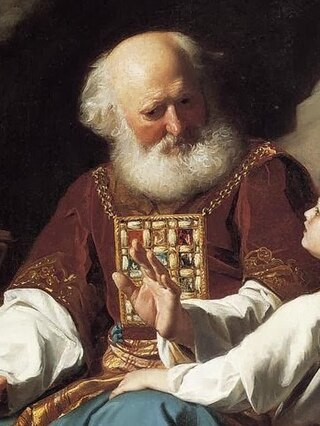
Eli was, according to the Book of Samuel, a priest and a judge of the Israelites in the city of Shiloh, ancient Israel. When Hannah came to Shiloh to pray for a son, Eli initially accused her of drunkenness, but when she protested her innocence, Eli wished her well. Hannah's eventual child, Samuel, was raised by Eli in the tabernacle. When Eli failed to rein in the abusive behavior of his own sons, God promised to punish his family, which resulted in the death of Eli's sons at the Battle of Aphek where the Ark of the Covenant was also captured. When Eli heard the news of the captured Ark, he fell from his seat, broke his neck, and died. Later biblical passages mention the fortunes of several of Eli's descendants.

The Changing People, dubbed the Deviants by the Eternals, are a fictional race of humanoids appearing in American comic books published by Marvel Comics.

Abin Sur is a superhero appearing in American comic books published by DC Comics. He was a member of the Green Lantern Corps and is best known as the predecessor of Green Lantern Hal Jordan, whom Abin Sur's power ring chose as his replacement. After the Infinite Crisis events, details of Abin Sur's past is altered and was revealed to be a brother-in-law of Sinestro and uncle of his daughter Soranik Natu. He was modeled after Yul Brynner.

The Storm Riders is a 1998 Hong Kong wuxia fantasy film based on the manhua series Fung Wan by artist Ma Wing-shing. Directed by Andrew Lau, it starred Ekin Cheng as Wind and Aaron Kwok as Cloud. The plot involves two children, Whispering Wind and Striding Cloud, who become powerful warriors under the evil Lord Conqueror's tutelage. A sequel to the film, titled The Storm Warriors was directed by the Pang brothers and released in 2009.

Blackstar is an American animated science fantasy television series, produced in 1981 by Lou Scheimer and Norm Prescott for Filmation. The series was Filmation's second fantasy epic, the first being The Freedom Force, a segment of Tarzan and the Super 7. Blackstar has many notable similarities to He-Man and the Masters of the Universe, which was produced shortly afterwards.

Swan Song is a 1987 horror novel by American novelist Robert R. McCammon. Published June 1, 1987, it is a work of post-apocalyptic fiction describing the aftermath of a nuclear war that provokes an evolution in humankind. Swan Song won the 1987 Bram Stoker award, tying with Stephen King's Misery.
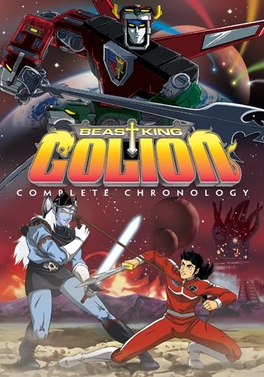
Beast King GoLion is a Japanese super mecha anime television series. The animation from GoLion was edited and trimmed to create the version of the American series Voltron: Defender of the Universe, with new names and dialogue. In 2008, GoLion was released on Region 1 DVD in three volumes. To coincide with the anime's original run, a manga adaptation by Yoshiki Tsuchiyama was serialized in TV Land.
The Twins of Destiny was a 1991 animated television series produced by French writer Jean Chalopin. It followed the fictional quest of two children, Jules and Julie, in their travels across Eurasia seeking to overthrow the Empress Dowager of China, and consequently, release their fathers from imprisonment. The English dubbed version first aired in Australia on December 27, 1994 on the ABC network. The animation was translated and introduced to China in mid-1990s.
This is a list of terminology used in the fictional Dune universe created by Frank Herbert, the primary source being "Terminology of the Imperium", the glossary contained in the novel Dune (1965).
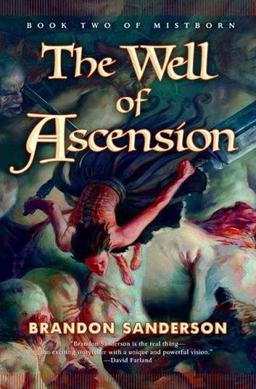
Mistborn: The Well of Ascension is a fantasy novel written by American author Brandon Sanderson. It was published on August 21, 2007, by Tor Books and is the second novel in the Mistborn trilogy. It is preceded by The Final Empire in 2006 and followed by The Hero of Ages in 2008.

Mistborn: The Hero of Ages is an epic fantasy novel written by American author Brandon Sanderson. It was published on October 14, 2008, by Tor Books and is the third and final novel in the Mistborn trilogy. It is preceded by The Well of Ascension in 2007 and followed by The Alloy of Law in the Mistborn: Era 2 series, Wax and Wayne in 2011.
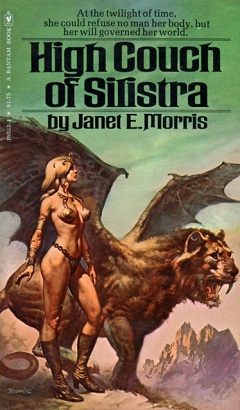
High Couch of Silistra is a science fiction novel, the first book in the Silistra quartet by American writer Janet Morris, published in 1977 by Bantam Books. High Couch of Silistra was the debut title of Morris' writing career. The series went on to have more than four million copies in print and was also published in French, Italian and German.
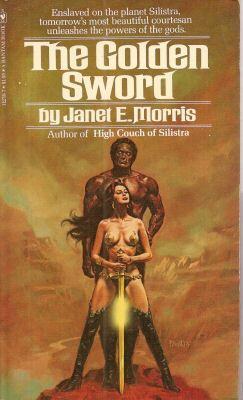
The Golden Sword, published in 1977, is a science fantasy novel by American writer Janet Morris, the second title in her High Couch of Silistra series.
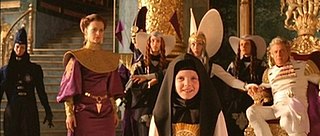
Multiple organizations of the Dune universe dominate the political, religious, and social arena of the setting of Frank Herbert's Dune series of science fiction novels, and derivative works. Set tens of thousands of years in the future, the saga chronicles a civilization which has banned computers but has also developed advanced technology and mental and physical abilities through physical training, eugenics and the use of the drug melange. Specialized groups of individuals have aligned themselves in organizations focusing on specific abilities, technology and goals. Herbert's concepts of human evolution and technology have been analyzed and deconstructed in at least one book, The Science of Dune (2008). His originating 1965 novel Dune is popularly considered one of the greatest science fiction novels of all time, and is frequently cited as the best-selling science fiction novel in history. Dune and its five sequels by Herbert explore the complex and multilayered interactions of politics, religion, ecology and technology, among other themes.
We've a three-point civilization: the Imperial Household balanced against the Federated Great Houses of the Landsraad, and between them, the Guild with its damnable monopoly on interstellar transport.















